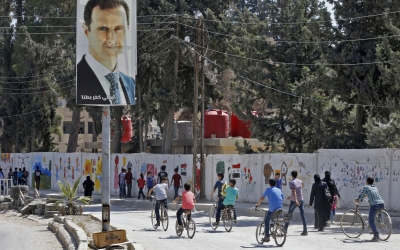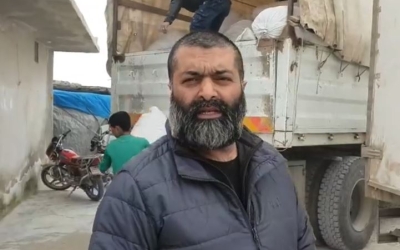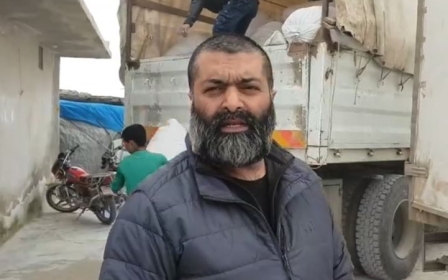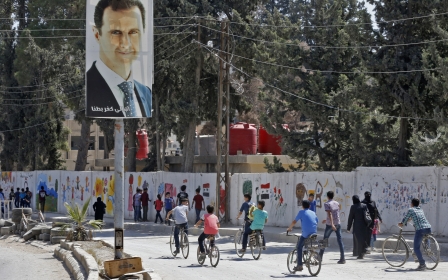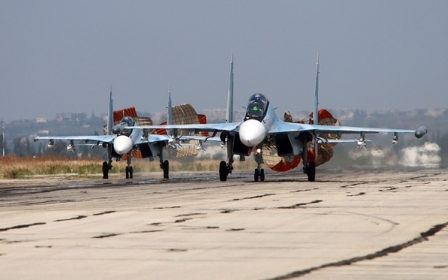Deadly strike hits Syria market as fighting rages in Damascus and northwest

Syrian government air strikes killed 18 civilians, including a dozen people at a busy market, as international observers expressed concerns about the use of chlorine gas by the government forces of Bashar al-Assad.
Government forces battled to repel a militant counteroffensive around the town of Kafr Nabuda in the northern Hama governorate that has left 70 combatants dead in 24 hours, the Britain-based Syrian Observatory for Human Rights said.
The Hayat Tahrir al-Sham alliance, led by Syria's former al-Qaeda affiliate, controls a large part of Idlib province as well as adjacent slivers of Aleppo, Hama and Latakia provinces.
The militant-dominated region is nominally protected by a buffer zone deal, but the government and its ally Russia have escalated their bombardment in recent weeks, seizing several towns on its southern flank.
At least 12 people were killed and another 18 wounded when government warplanes hit the militant-held Idlib province town of Maarat al-Numan around midnight (2100 GMT) on Tuesday, the Observatory said.
New MEE newsletter: Jerusalem Dispatch
Sign up to get the latest insights and analysis on Israel-Palestine, alongside Turkey Unpacked and other MEE newsletters
The market was crowded with people out and about after breaking the daytime fast observed by Muslims during the holy month of Ramadan.
The bombardment blew in the facades of surrounding buildings, and ripped through the flimsy frames and canvas of stalls in the market square, an AFP photographer reported.
The bodies of market-goers were torn apart.
"Residents are still scared," stallholder Khaled Ahmad told AFP news agency.
Three more civilians were killed on Wednesday by air strikes in the nearby town of Saraqib, the Observatory said.
Two others were killed in strikes on the town of Maaret Hermeh, it added.
Another civilian was killed in air raids on the town of Jisr al-Shughur, the monitor said.
The Britain-based Observatory relies on a network of sources inside Syria and says it determines whose planes carried out strikes according to type, location, flight patterns and munitions.
On Tuesday, the US State Department said it saw signs that the Syrian government may be using chemical weapons, including an alleged chlorine attack on Sunday in the northwest province of Idlib.
"We have full confidence in the Organisation for the Prohibition of Chemical Weapons," it added.
In an online press briefing, the French foreign ministry said it "noted with a degree of alarm these allegations, which need to be looked into".
Meanwhile, HTS accused government forces of launching a chlorine gas attack on its fighters in the northern mountains of Latakia. But the Observatory said Wednesday it had "no proof at all of the attack".
'Worst fears'
The strikes came as heavy clashes raged in neighbouring Hama province after the militants launched a counterattack on Tuesday.
Fresh fighting on Wednesday took the death toll to 70 - 36 government forces and militia and 34 militants, the Observatory said.
It said the militants had recaptured most of Kafr Nabuda from government forces, who had taken control of the town on 8 May.
State news agency SANA on Wednesday, however, said the army repelled a militant attack in the area, killing dozens of rebels.
Russia and rebel ally Turkey inked the buffer zone deal in September to avert a government offensive on the region and protect its three million residents.
But Assad's government upped its bombardment of the region after HTS took control in January.
Russia too has stepped up its air strikes in recent weeks.
The Observatory says nearly 200 civilians have been killed in the flare-up since 30 April.
The United Nations said Wednesday that Idlib's civilian population once again faced the threat of an all-out offensive.
"A full military incursion threatens to trigger a humanitarian catastrophe for over 3 million civilians caught in the crossfire, as well as overwhelm our ability to respond," said David Swanson, a spokesman for the UN humanitarian office.
Swanson said more than 200,000 people have been displaced by the upsurge of violence since 28 April.
A total of 20 health facilities have been hit by the escalation - 19 of which remain out of service, Swanson said.
Collectively they served at least 200,000 people, he added.
'Status quo'
The September deal was never fully implemented as militants refused to withdraw from a planned buffer zone around the Idlib region.
But it ushered in a relative drop in violence until earlier this year, with Turkish troops deploying to observation points around the region.
The Syrian government has accused Turkey of failing to secure implementation of the truce deal by the militants.
But Turkish Defence Minister Hulusi Akar accused the Syrian government late Tuesday of threatening the ceasefire deal.
"The regime is doing all that it can to break the status quo including using barrel bombs, land and air offensives," Akar told reporters.
"Turkish armed forces will not take a step back from wherever they may be," he however added.
Middle East Eye delivers independent and unrivalled coverage and analysis of the Middle East, North Africa and beyond. To learn more about republishing this content and the associated fees, please fill out this form. More about MEE can be found here.


